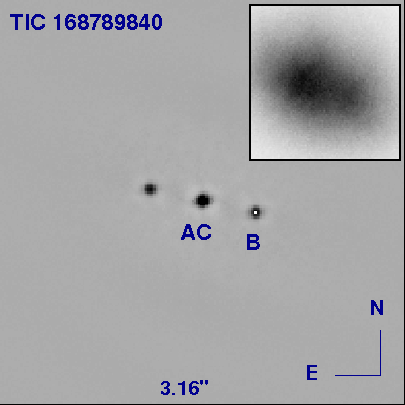SOAR participates in study of sextuple eclipsing binary
Submitted by jelias on Sun, 2021-01-24 21:35
A rare stellar system has been discovered by NASA’s Transiting Exoplanet Survey Satellite (TESS) and studied by an international team using several telescopes, including the SOAR Telescope and the CTIO 1.5-m. The lead authors, Brian Powell and Veselin Kostov from the Goddard Space Flight Center, discovered that the 11th magnitude star TIC 168789840 observed by TESS contains three close binaries, all of them eclipsing (periods 1.5, 1.3, and 8 days). New and archival ground-based data helped the international team of researchers to establish the structure and physics of this unique system. The three eclipsing pairs are composed of stars with similar primary components and mass ratios, posing a new challenge to theories of multiple-star formation.
The system was observed at SOAR by NOIRLab staff scientist Andrei Tokovinin, a co-author on the paper, using the HRCam speckle camera on October 27, shortly after re-opening, and was clearly resolved into a pair with a 0.423" separation and a moderate magnitude difference of 0.27 mag. The picture shows the speckle auto-correlation function, where the central peak (AC) corresponds to the brighter component (it contains 4 stars that are too close to be resolved), and one of the two symmetric peaks corresponds to the fainter component B (which contains the third eclipsing binary). The correct position for the B component is indicated. The image quality was quite good (FWHM resolution 0.6"), so even in the classical stacked image the pair is partially resolved (see the insert).
In parallel, high-resolution spectroscopy with CHIRON on the CTIO 1.5-m telescope provided measurements of the mass ratios of the eclipsing pairs.
SOAR plays a key role in ground-based support of the TESS exo-planet program by surveying southern candidate targets for companions: about two thousand TESS objects of interest have been observed with HRCam at SOAR to date. See the November, 2019 Currents article for more information.
The paper was accepted by the Astrophysical Journal and a preprint is available at arxiv.org.
Updated on May 15, 2024, 11:14 am
